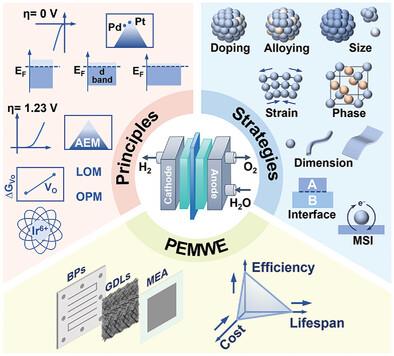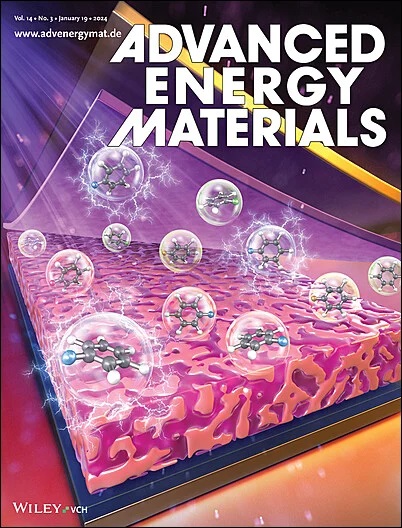Design Principle and Regulation Strategy of Noble Metal-Based Materials for Practical Proton Exchange Membrane Water Electrolyzer
IF 24.4
1区 材料科学
Q1 CHEMISTRY, PHYSICAL
引用次数: 0
Abstract
Green hydrogen holds immense promise in combating climate change and building a sustainable future. Owing to its high power-to-gas conversion efficiency, compact structure, and fast response, the proton exchange membrane water electrolyzer (PEMWE) stands out as the most viable option for the widespread production of green hydrogen. However, the harsh operating conditions of PEMWE make it heavily dependent on noble metal-based catalysts (NMCs) and incur high operational and maintenance costs, which hinder its extensive adoption. Hence, it is imperative to improve the performance and lifespan of NMCs and develop advanced components to reduce the overall costs of integrating PEMWE technology into practical applications. In light of this, the fundamental design principles of NMCs employed in acidic water electrolysis are summarized, as well as recent advancements in compositional and structural engineering to enhance intrinsic activity and active site density. Moreover, recent innovations in stack components of practical PEMWE and their impact on cost-benefit and lifespan are presented. Finally, the current challenges are examined, and potential solutions for optimizing NMCs and PEMWE in electrocatalytic hydrogen production are discussed.

实用质子交换膜水电解槽贵金属基材料的设计原理与调控策略
绿色氢气在应对气候变化和建设可持续未来方面大有可为。质子交换膜水电解槽(PEMWE)具有电能-气体转换效率高、结构紧凑、响应速度快等优点,是广泛生产绿色氢气的最可行方案。然而,质子交换膜水电解槽苛刻的运行条件使其严重依赖贵金属催化剂(NMC),并产生高昂的运行和维护成本,阻碍了其广泛应用。因此,当务之急是提高 NMC 的性能和使用寿命,并开发先进的组件,以降低将 PEMWE 技术集成到实际应用中的总体成本。有鉴于此,本文总结了酸性水电解所采用的 NMC 的基本设计原理,以及为提高内在活性和活性位点密度而在成分和结构工程方面取得的最新进展。此外,还介绍了实用 PEMWE 堆栈组件的最新创新及其对成本效益和使用寿命的影响。最后,研究了当前面临的挑战,并讨论了在电催化制氢过程中优化 NMC 和 PEMWE 的潜在解决方案。
本文章由计算机程序翻译,如有差异,请以英文原文为准。
求助全文
约1分钟内获得全文
求助全文
来源期刊

Advanced Energy Materials
CHEMISTRY, PHYSICAL-ENERGY & FUELS
CiteScore
41.90
自引率
4.00%
发文量
889
审稿时长
1.4 months
期刊介绍:
Established in 2011, Advanced Energy Materials is an international, interdisciplinary, English-language journal that focuses on materials used in energy harvesting, conversion, and storage. It is regarded as a top-quality journal alongside Advanced Materials, Advanced Functional Materials, and Small.
With a 2022 Impact Factor of 27.8, Advanced Energy Materials is considered a prime source for the best energy-related research. The journal covers a wide range of topics in energy-related research, including organic and inorganic photovoltaics, batteries and supercapacitors, fuel cells, hydrogen generation and storage, thermoelectrics, water splitting and photocatalysis, solar fuels and thermosolar power, magnetocalorics, and piezoelectronics.
The readership of Advanced Energy Materials includes materials scientists, chemists, physicists, and engineers in both academia and industry. The journal is indexed in various databases and collections, such as Advanced Technologies & Aerospace Database, FIZ Karlsruhe, INSPEC (IET), Science Citation Index Expanded, Technology Collection, and Web of Science, among others.
 求助内容:
求助内容: 应助结果提醒方式:
应助结果提醒方式:


